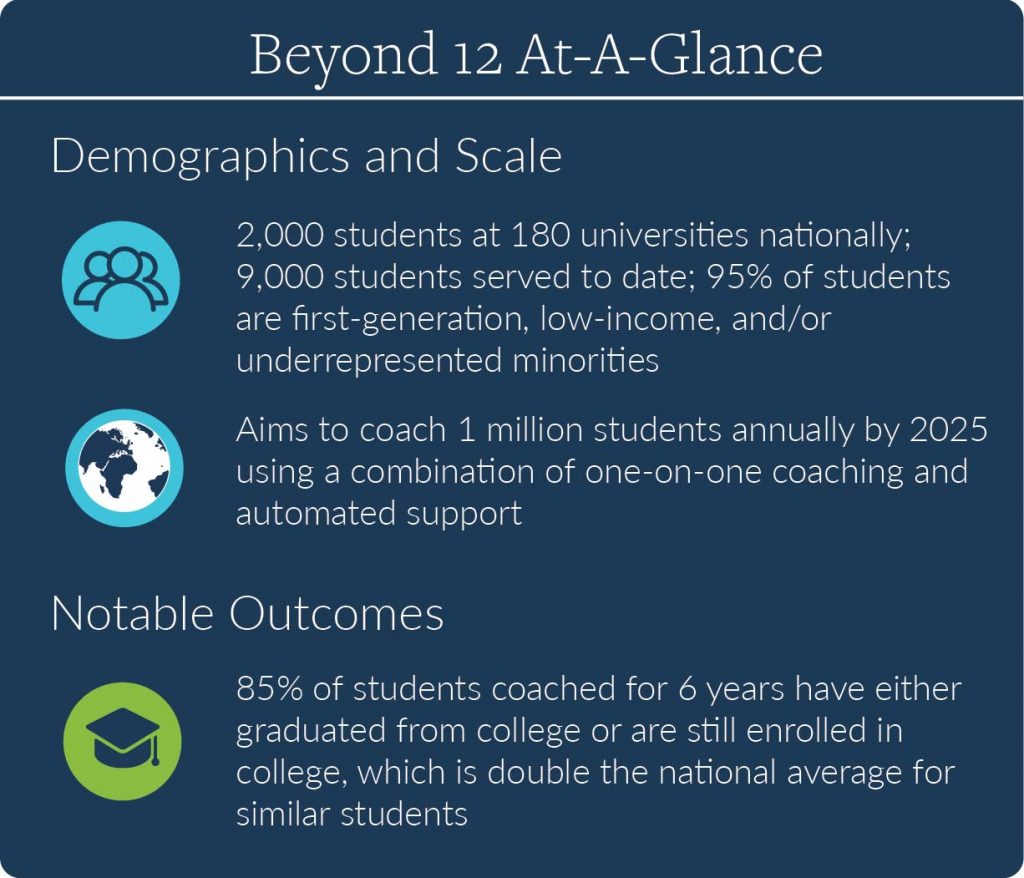Students need relationships to get by and to get ahead. But all too often in our education system, relationships are treated as inputs to learning, rather than outcomes in their own right. We’re offering in-depth profiles of programs that are flipping that script and deliberately designing models to deepen and diversify students’ networks. This is the fifth piece in our Who You Know in Action blog series. Read the first piece here, the second piece here, the third piece here, and the fourth piece here.
In 2019, automation and human connection are often seen at odds. But one organization is showing how technology and human relationships can go hand in hand. Beyond 12 is a nonprofit that offers virtual one-on-one coaching to low-income, first-generation, and historically underrepresented students to support them through college. The model has arisen in an era of unprecedented college enrollment among traditionally underserved populations, but also amid troubling and persistent gaps in degree attainment. Just 9% of low-income students earn a bachelor’s degree by their mid-20s, compared with 77% of their wealthy peers. Beyond 12 is working to cure these gaps, one coach—and chatbot—at a time.
Beyond 12 has coached over 9,000 students and, today, coaches over 2000 students on 180 college campuses and it has bold plans to scale. “For us, scaling is about equity,” said Alexandra Bernadotte, Beyond 12’s Founder and CEO. “The idea that success for some students comes down to happenstance—and you get a limited solution if you are lucky enough to attend the right high school, after school program, or college—is unsettling.” To better those chances, looking ahead, the organization aims to reach 1 million students by 2025.

How can a coaching model scale that quickly? Technology, the backbone of Beyond 12’s MyCoach app, plays a big role. “We didn’t create an app because we could, we created an app because we simply couldn’t afford not to,” Bernadotte explained. But Beyond 12 stands apart from many technologies that gradually automate away relationships as services expand. Instead, Beyond 12’s team is building out sophisticated data analytics and chatbots that amplify and scale student-coach relationships. “We believe that a high-tech, high-touch solution is the key to achieving social impact at scale,” Bernadotte said.
Here are four ways that Beyond 12 is using technology to both scale and deepen student-coach connections:
1. Reserving scarce time for inspiration, not transaction
Beyond 12’s curriculum adheres closely to the philosophy of co-active coaching, in which coaches and coachees are active collaborators, working together as equals. As the organization scales, it’s finding ways to increase coach:student ratios (currently 1:100) without sacrificing the deep relationship at the heart of its model.
To that end, in recent years, the product team behind Beyond12’s MyCoach app set out to discover instances when coaches and students were spending precious time in less meaningful interactions, where time spent did not amount to trust built, explained Chris Co, Beyond 12’s Chief Technology Officer and Head of Product. The number-one use case they’ve discovered thus far? Coaches and students were spending significant time messaging back and forth to schedule their coaching sessions. Now the product team is building a chatbot to take on that task. In turn, coaches will have more time to add additional students to their caseloads—without giving up crucial time dedicated to forming deep relationships.
2. Seeing patterns build over time
Chatbots can alleviate some of the transactional burdens on coaches’ time, but data can also make time set aside for real-time coaching much higher yield. Beyond 12’s backend technology is expanding the aperture through which coaches can see a student’s path through college. Given their caseloads, coaches may not see the patterns that emerge in each and every student’s path over time. “Each challenge feels idiosyncratic,” said Eve Shapiro, Beyond 12’s Senior Director of Data and Research. For example, a coach might miss that a given student tends to struggle to get back into the swing of school in his Fall term. But with better data and analytics, Shapiro’s team is helping to reveal patterns that are otherwise invisible to coaches. Armed with data that illustrates patterns over time, coaches can move beyond supporting students through one-off seemingly idiosyncratic challenges to preventing patterns from repeating themselves over time.
3. Coaching in a proactive, rather than reactive, manner
Seeing those patterns is just the beginning of Beyond 12’s work to infuse predictive analytics (showing patterns in students’ pathways over time) and prescriptive analytics (recommending particular actions or topics to coaches based on those patterns) into the MyCoach app. “Student pathways aren’t linear,” Shapiro explained. “Understanding which students need support at a given point in time isn’t simply based on incoming need or academic preparation.” Instead, Shapiro explained, as students progress through college, a whole range of external events or unanticipated structural barriers to their success can arise. And even the best coaches may see signs of those events later than is ideal. Most traditional metrics that indicate a student may be off track, like receiving middling grades or being put on academic probation, lag behind the student’s actual struggle. “By the time you get that information as a coach, the most powerful moment has passed,” said Shapiro.
Making sense of more and better data can beat that lag. “For the last couple years, we’ve worked hard to ingest more data to help us understand where students were successful and why,” said Shapiro. “Our predictive analytics have tried to hone in on signals and patterns early.” This includes their own insights from qualitative data on student-coach interactions and quantitative data on student success rates, as well as third-party data on success rates for specific institutions and demographic subgroups. Capturing and analyzing this data is becoming an engine for Beyond 12 coaches to take a more differentiated approach. Today, coaches have access to a sophisticated dashboard that shows a whole range of indicators that could signal a student is at risk. From there, coaches can prioritize their time, targeting conversations with students who are in need of just-in-time check-ins or higher dosages of support.
4. Following students, not institutions
Although technology can lend both efficiencies and data-driven insights to the coaching model, it offers another upside to supporting a student population with relatively high transfer rates: flexibility. If a student transfers schools, her relationship with an institution may end, but her relationship with Beyond 12 does not. Through the app, she can still access Beyond 12 coaching on her path to a degree. For Beyond 12, that flexibility offers an important counterpoint to investments in exclusively on-campus supports. “When you centralize all supports within single institutions, what happens for students moving among institutions? Those networks and supports disappear,” said Shapiro. That is not to say that Beyond 12 discounts the critical role that institutional supports play in helping students to successfully graduate; its curriculum explicitly urges students to forge connections with their on-campus support services like tutoring centers, career services, and professors. But MyCoach supports do not reside on a single campus by design. “We also help them build networks and mentoring relationships extra-institutionally, growing their social capital” Shapiro said.
In a cash-strapped, efficiency-obsessed higher education market, there’s an understandable temptation to dismiss high-touch relationships as inherently impossible to scale. There’s also a temptation to supplant human connections with tech-based nudges. But those claims and approaches discount the fact that technology is a tool that, when used correctly, can expand access and affordability for cost-intensive relationships themselves. Helping to keep students on track to graduation is an exceedingly complex endeavor that can’t be outsourced to a collection of 0’s and 1’s. But it’s also an endeavor where combining the power of technology, analytics, and human supports may be our best hope for tackling graduation gaps.


